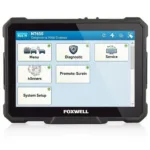The OBD2 battery voltage PID (Parameter ID) is a crucial piece of data accessible through your OBD2 scanner. It provides real-time insights into your vehicle’s electrical system health and can be instrumental in diagnosing a variety of issues. Understanding how to access and interpret this data can empower you to troubleshoot problems and maintain your car’s electrical system effectively. This article will delve into the importance of the OBD2 battery voltage PID, how to retrieve it, and what the readings signify.
Accessing the battery voltage through your OBD2 scanner is generally straightforward. Most scanners display this information automatically on the main dashboard screen. However, if it isn’t readily visible, you can usually find it listed under PIDs related to the powertrain or battery management system. If you’re having trouble locating the OBD2 battery voltage PID, consulting your scanner’s manual or the manufacturer’s website can be helpful. Knowing your vehicle’s battery voltage is particularly useful when diagnosing starting problems or other electrical issues. For example, if the voltage reading is significantly lower than expected, it could indicate a failing battery, a faulty alternator, or even a parasitic drain on the electrical system.
Decoding the OBD2 Battery Voltage PID: What the Numbers Mean
A healthy car battery typically reads between 12.6 volts and 14.7 volts with the engine off. With the engine running, the voltage should increase to around 13.7 to 14.7 volts, indicating that the alternator is charging the battery correctly. If you’re unsure about your vehicle’s specific voltage requirements, check your owner’s manual. It will often provide a recommended voltage range for your make and model. Regularly monitoring your OBD2 battery voltage PID can provide early warnings of potential problems, helping you address them before they escalate into more costly repairs.
Troubleshooting with the OBD2 Battery Voltage PID
The OBD2 battery voltage PID isn’t just for checking if your battery is good. It’s a powerful diagnostic tool. Low voltage can signify a variety of issues: a failing battery, a bad alternator, corroded battery terminals, or even a parasitic draw draining your battery while the car is off. High voltage, although less common, can also signal problems, such as a faulty voltage regulator. Understanding what these different voltage readings mean allows you to pinpoint the source of the problem more accurately. You can check the best OBD2 scanner for electric cars.
OBD2 Battery Voltage PID: Beyond the Basics
While the battery voltage PID is essential, it doesn’t exist in a vacuum. It can be combined with other PIDs to give you a comprehensive understanding of your car’s electrical system. For example, by monitoring the charging system voltage alongside the battery current PID, you can get a complete picture of how your alternator is performing. You can learn more about OBD2 LeafSpy. This more holistic approach can be invaluable for diagnosing complex electrical issues. Additionally, understanding the OBD2 pin out power can offer further insights into your vehicle’s electrical system.
Conclusion: Harnessing the Power of the OBD2 Battery Voltage PID
The obd2 battery voltage PID is a valuable tool for any car owner. From diagnosing a dead battery to understanding the complexities of your car’s electrical system, this simple data point provides crucial information. Regularly monitoring your obd2 battery voltage PID can save you time, money, and frustration by catching potential issues early on. Learn more about obd2 hybrid battery. And, if you’re looking for more information on specific Chevy OBD2 codes, be sure to check out our comprehensive list of Chevy obd2 codes.
FAQ:
-
What is a normal OBD2 battery voltage PID reading?
A healthy battery usually reads between 12.6V and 14.7V with the engine off, and 13.7V to 14.7V with the engine running. -
What does a low OBD2 battery voltage PID indicate?
It can indicate a failing battery, a bad alternator, or a parasitic draw. -
What does a high OBD2 battery voltage PID indicate?
It could point to a faulty voltage regulator. -
Where can I find the OBD2 battery voltage PID on my scanner?
It’s usually displayed on the main dashboard or under PIDs related to powertrain or battery management. -
How can I use the OBD2 battery voltage PID for troubleshooting?
By comparing the reading with the expected voltage range, you can identify potential issues with the battery, alternator, or charging system. -
Why is it important to monitor the OBD2 battery voltage PID regularly?
Regular monitoring allows for early detection of potential problems, preventing costly repairs down the road. -
Can the OBD2 battery voltage PID be used with other PIDs for more comprehensive diagnostics?
Yes, combining it with other PIDs like battery current can provide a complete picture of the electrical system’s health.
Need help with your car diagnostics? Contact us via WhatsApp: +1(641)206-8880, Email: [email protected] or visit us at 789 Elm Street, San Francisco, CA 94102, USA. We offer 24/7 customer support. For more information on related topics, explore our articles on OBD2 scanners and car diagnostics.


